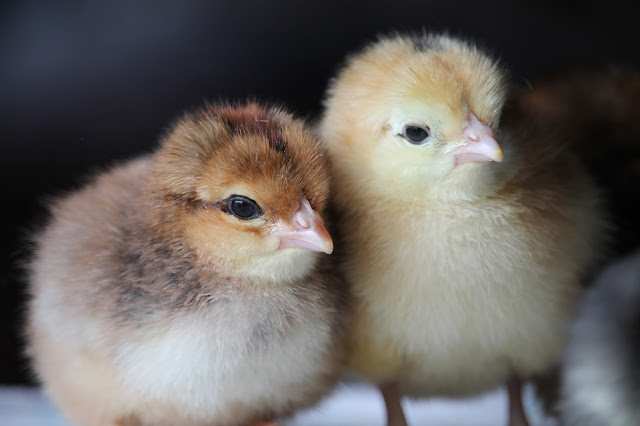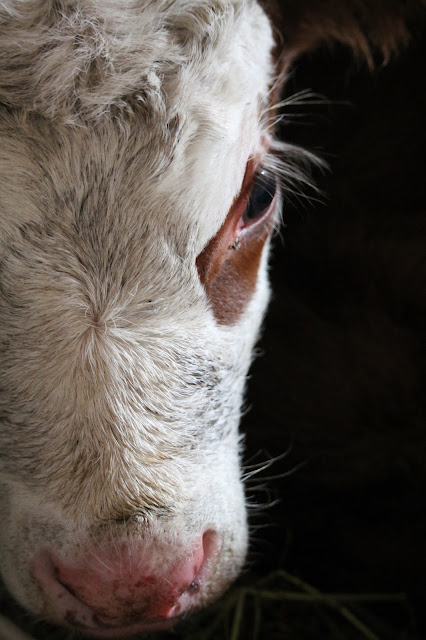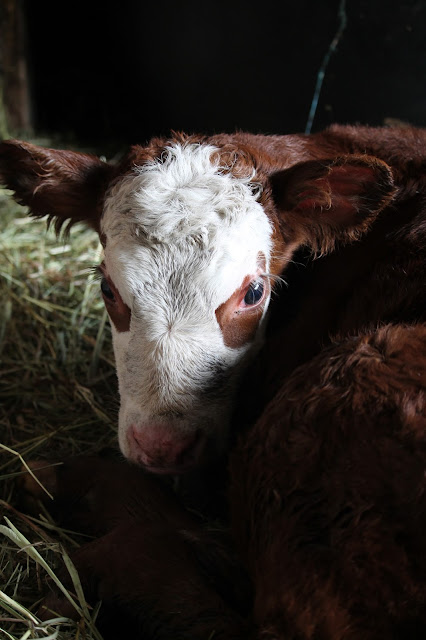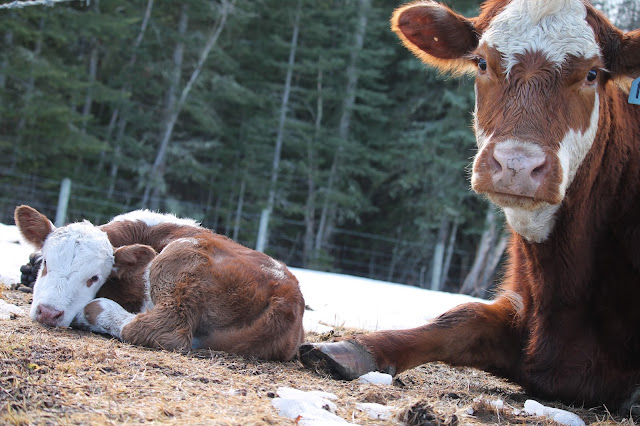But I won't entirely! Here are a couple pictures of this winter.
Callie's frosty eyes
Beautiful Tansy
Matt and little farm girl preparing to sort heifers
I had my hands thoroughly full with farm chores, mothering and homeschooling. Winter was a bit of a blur. I am just loving the ages of my littles and how we can enjoy reading all sorts of classic books together! All in all, it was a great winter on the farm!
Introducing the littlest farmer to some of the spring creatures
Little farmers enjoying a windy spring day
A sure sign of spring: Chickies!
Milo and Callie with spring fever!
The worst part of spring time. Yuck. We have been dangerously close to getting stuck, but the critters need to eat!
And the big event of our springtime: Calving!
I feel like in comparison to this year, I was simply a spectator at last years calving. With exception to one calf we bottle fed colostrum to, everything went perfectly smoothly. All the calves came with no issue and no assistance and the mothers did all the work.
At the beginning of this calving, Matt said to me, "I hope we have some trouble this year just so we can learn." It was a terrible thing to ask for, because trouble certainly came!
Our calving started six weeks before the calves were due, with two still born calves. It was very disappointing way to get started.
The first still born calf jump-started us to work out a calving setup that would be ready in case of trouble. We brought the heifers close to the house and set up two covered run in shelters ready for new mommas, with our maternity calving pen in close proximity.
This is a cow in the run in shelter, the green pen behind her is our maternity pen. It turned out to be a fantastic set up for us. All our heifers chose to
calve in the sheltered run in stalls and then we closed them in so they
could bond with their babies for a day or two.
The cow in the picture above we call "the mother hen." She mothers everyone else's babies, and when its time to give a new calf vitamin injections, she is usually more upset than the mother!
This was a nice surprise partway through calving. The little heifer in the picture above is not sired by our Red Angus bull. It was quite the head scratcher to find in the early morning. We have two calves so far who are the spitting image of the bull across the fence from our girls.
I definitely did a ton of learning this year. So, so, so much learning that when I think of myself at the beginning of calving, I can't believe how inexperienced and naive I was! It seems that experience is acquired through making mistakes, and I made so many mistakes and bad judgement calls that I ran out of mistakes to make!
The first round of experience getting was pulling my first calf. I knew something was wrong quite early in the morning. It was a first time heifer, and her labour just wasn't progressing like I felt like it should. When I finally got uncomfortable enough, I called Matt at work. We decided to wait and see and for half an hour. After that had passed I knew something was definitely wrong and I messaged him: "Come home, we need to pull this calf!" Unfortunately employers don't take calving into account when they plan their agenda and Matt called back to say he wasn't coming home and I should call the local vet to help me pull. The vet happened to be on an emergency call already and by the time I had all this sorted out the day was slipping by and I could see the stuck calf's tongue beginning to swell! It was a terrible feeling jumping in having never have done it before. I got all the children corralled as best I could, herded the heifer into the maternity pen and got my trusy calving manual! I can't even begin to explain how much I learned that day, but it all ended well. A handsome little bull was born right into my lap!
The next struggles came with weak calves. We nicknamed them "dummy calves" and for a good reason. They were all large sized bull calves, but they seemed to be born acting all the same way. Droopy ears, hunched over posture, stumbly shuffly steps, and the worst part, a total inability to find the cows udder!
With the first one we played the wait and see game. A calf has to get colostrum in the first few hours or there can be life long consequences, so it wasn't a long game. We watched that calf all through the night and I ended up giving it a bottle of packaged colostrum at 2:00 and 4:00 am. Generally that will perk a cold stressed calf up and give it the energy to find the udder, but not in this case. By the morning the calf was a droopy little thing that would fall whenever we put him on his feet. Matt made the call to bring the cow to the maternity pen and intervene. The first thing we had to learn was how to bring a cow and calf in, and then how to restrain the cow so we could physically put her calf on her udder. Matt got a couple kicks while we straightened out the kinks! Then the struggle with the calf began. With the calf lying across my lap and the both of us holding it up and onto the udder, and milking into its mouth, we still couldn't get him to suck! We injected him with Selenium, vitamins E, A, D and a B spectrum. I went out through the day and nights and held him on her udder. I would get her milk flowing and then wrestle him over to her, onto her udder and hold his mouth on a teat while I milked the other quarters. Then when I absolutely couldn't get him wrestled onto her to a minute longer, I would force feed him all the milk I had milked out of her.
After a few days of watching him slowly fading, I finally did some reading about the very appropriately named "dummy calf syndrome" and I tried something new. I borrowed some fresh milk from a friends jersey cow and when I finished my usual wrestling match, I force fed him a whole bottle, mixed with packaged colostrum. Shortly after, I noticed his droopy head come up for a second and sniff at the wall of the barn. There was a spark of light in his eyes! A tiny victory! The next day, I just had to wake him and stand him on his feet and push him to the udder but once I showed him a teat, he would nurse hungrily! And then finally, he had the energy to do it all on his own! I felt so relieved and accomplished!
This is one of my dummy calves, now out with the herd!
My sense of accomplishment was quickly dashed as two more little bulls were born, both showing the dreaded hunched over position. They took my every baby nap time, every evening, every getting up early before the kids were awake, every spare second and more. I don't know if I could have handled one more dummy calf! But I learned from each one, so much from each one! The first lesson being "don't ever wait and see." If a calf is not nursing and vigorous, its not right! The second lesson being "don't spend all your time wrestling calves onto udders." It is far more useful to milk the cow and get it all in the calf. Once the calf is perked up and on its feet, guiding him onto the udder is productive! Besides those memorable lessons I learned so many skills. Basic cow handling, calf wrestling, hand milking, foot snaring, kick tying skills that you can't learn to confidently do just from a book.
The neatest part of trying to get those dummy calves on their feet was working through things with the cow.
The first time I would have to fight them into the headgate by herding them and twisting their tails to motivate them forward. Once they were caught I had to snare a wildly kicking and thrashing foot. Some of them fought hard enough to rock the whole maternity pen away from the barn. Once I got a foot tied up I had to keep my arms and the calf out of the way of the thrashing. Half way through milking and feeding the calf, the cow would settle down and her head would drop low. When I released the foot at the end, I could simply reach down into the kick zone and freed her leg while she stood quietly.
The second milking would be a totally different experience. The cow would walk quietly to the headgate with very little encouragement. There would be no thrashing, a few halfhearted kicks if any. She would stand with her head low while I wrested her calf and milked. Once the routine was established, she as cooperative as could be. The cow I spent the most time with, I milked easily loose in the pen after the first two days. It was exciting to see the quick change in the cow. It was as if there was a bit of a kinship in working together to get the calves back on their feet.
Those were a few wins, but there were loses and hard lessons too. The regret of making bad judgement calls, the heavy guilt of a lost calf who didn't get pulled in time, hours and hours spent in the dark of night watching and hoping to see a brand new calf turn the corner and thrive.
And weirdly enough, this Raven who is almost always out there with us. Sometimes as I sit and do my checks, he sits withing six feet of me. It used to feel so peculiar, and now through the hours that I have spent out there, it has become companionable. His weird watery drippy sounds feel like they expect me to answer.
When I think back on it all, I am sure our adventures would be just an average day to a full time farmer. There is something about doing something for the first time that makes it feel so much more momentous and that's one of the reasons I thought I would blog this calving. Next year it all might be just a normal day on the farm!
And as of today, there are only three more calves to come.
I was saying to Matt that I feel a sense of disappointment that Calving 2017 is winding down. He thoughtfully offered to let me do all the nighttime checks and that gave me a little better perspective!

























Thank you for sharing your first time calving experiences with us sweetie. It is wonderful to see how are doing, and how quickly you can adapt and successfully take on the challenges of farming. Very impressive. xo
ReplyDelete